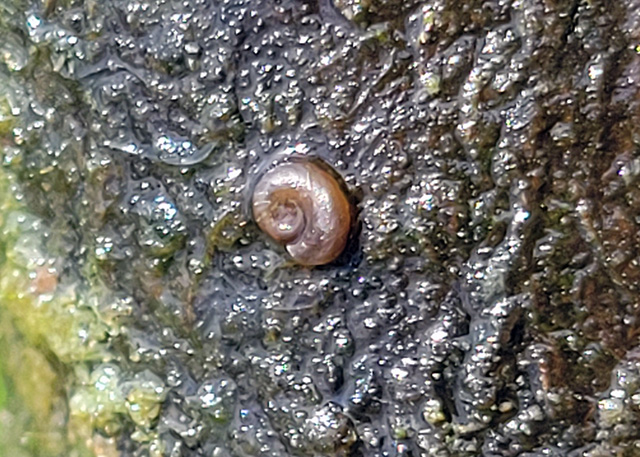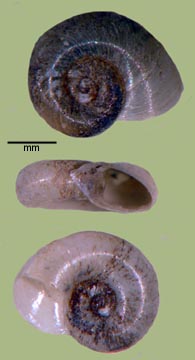> Habitat & Distribution
Gyraulus parvus is widespread in ponds, impoundments, and slow-moving rivers throughout North America, from Canada to Florida, Atlantic to Pacific (Baker, 1928; Clarke, 1981; Thompson, 1999). Populations have also spread through much of northern Europe, where they have been confused with the native G. laevis (Meier-Brook 1983).
Gyraulus parvus populations seem best adapted to richer, more permanent, lacustrine environments, and is not typically found in intermittent or temporary waters or swamps. They seem to reach maximum densities on floating vegetation, especially underneath the leaves of water lilies in larger lakes and riverine backwaters. In our 17-state study area, G. parvus seems a bit more common in the northeast, and less common in the Tennessee/Cumberland, probably on account of available lentic habitat. FWGNA incidence rank I-5.
> Ecology & Life History
Gyraulus parvus populations have figured in a variety of ecological studies in northern lakes (Horst & Costa 1971, Sheldon 1987, Osenberg 1989) but are not well studied in the south. Jokinen (1987) characterized G. parvus as a C-D tramp in New England, characteristic of habitats occurring virtually everywhere she sampled. Dillon s (2000: 360-363) reanalysis of these data suggested that G. parvus populations in Connecticut seem to be Undifferentiated with respect to life history adaptation.
The Canadian population studied by McKillop (1985) displayed a simple annual life cycle (A). The effect of fish predation on G. parvus populations has been investigated by Martin et al. (1992) and Thorp & Bergey (1981). The interesting dispersal expriments of Malone (1965), although nominally involving Promenetus, were probably conducted on Gyraulus parvus. See my essay of 15Dec16 from the link below.
> Taxonomy & Systematics
Originally described in the genus Planorbis, Thomas Say's (1817) nomen parvus has remained taxonomically stable since its transfer to Gyraulus in the early 20th century. Dall considered circumstriatus, parvus, and several more obscure taxa sufficiently distinct from other Gyraulus that he proposed a "section" Torquis to contain it, which Baker (1945) considered a subgenus.
Lorencova and colleagues (2021) have recently suggested, on the basis of a large and impressive set of DNA sequence data, that European populations previously identified as Gyraulus laevis (Alder, 1838) might be conspecific with North American G. parvus. See my essay of 4Feb22 from the link below for a reanalysis of those data, suggesting the contrary.
The classification of the Planorbidae proposed by the tag team of Baker (1945) and Hubendick (1955) remains, after 50 years, the basis for our understanding of this large and diverse family of pulmonates worldwide. See my essay of 11Apr08 from the link below for more.
> Maps and Supplementary Resources
- Gyraulus parvus distribution in Atlantic drainages (2023)
- Gyraulus distribution in Georgia and the Florida panhandle (2025)
- Gyraulus distribution in the drainage of The Ohio (2019)
- Gyraulus distribution in the Tennessee/Cumberland (2022)
- Gyraulus distribtion in The Great Plains (2024)
- This is really all there is to see...

> Essays
- See my post to the FWGNA blog of 11Apr08 for a review of the Classification of the Planorbidae.
- Or view the (Hubendick 1955) classification of North American planorbids in a tabular format [here].
- The charming dispersal experiments of Malone (1965) probably featured Gyraulus parvus misidentified as "Promenetus." See my 15Dec16 essay, Freshwater Gastropods Take to the Air, 1991.
- Lorencova et al. (2021) suggested that European populations identified as Gyraulus laevis might be conspecific with North American G. parvus. I critiqued this hypothesis in my essay of 4Feb22, Character phase disequilibrium in the Gyraulus of Europe.
> References
Baker, F. (1945) The Molluscan Family Planorbidae. Urbana: University of Illinois Press.
Baker, H. B. (1946) Index to F.C. Baker's "The Molluscan Family Planorbidae." Nautilus, 59, 127-41.
Dillon, R. T., Jr. (2000) The Ecology of Freshwater Molluscs. Cambridge University Press, Cambridge, England. 509 pp.
Horst, T. & R. Costa ( 1971) Distribution patterns of five selected gastropod species from McCargo Lake. Nautilus, 85: 38-43.
Hubendick, B. (1955) Phylogeny in the Planorbidae. Trans. Zool. Soc. London 28: 453-542.
Jokinen, E. (1987) Structure of freshwater snail communities: species-area relationships and incidence categories. Am. Malacol. Bull., 5: 9-19.
Lorencova, E., L. Beran, M. Novakova, V. Horsakova, B. Rowson, J. Hlavac, J. Nekola, and M. Horsak (2021). Invasion at the population level: a story of the freshwater snails Gyraulus parvus and G. laevis. Hydrobiologia 848: 4661 4671.
Malone, C. R. (1965) Killdeer (Charadrius vociferus) as a means of dispersal for aquatic gastropods. Ecology 46: 551-552.
Martin, T., L. Crowder, C. Dumas, & J. Burkholder (1992) Indirect effects of fish predation on macrophytes in Bays Mountain Lake: Evidence for a littoral trophic cascade. Oecologia, 89: 476-81.
McKillop, W. (1985) Distribution of aquatic gastropods across the Ordovician dolomite Precambrian granite contact in southeastern Manitoba. Can. J. Zool., 63: 278-88.
Meier-Brook, C. (1983) Taxonomic studies on Gyraulus (Gastropoda: Planorbidae). Malacologia 24: 1 113.
Osenberg, C. (1989) Resource limitation, competition and the influence of life history in a freshwater snail community. Oecologia, 79: 512-19.
Sheldon, S, P. (1987) The effects of herbivorous snails on submerged communities in Minnesota lakes. Ecology, 68: 1920-31.
Thorpe, J. & E. Bergey (1981) Field experiments on responses of a freshwater benthic macroinvertebrate community to vertebrate predators. Ecology, 62: 365-75.








